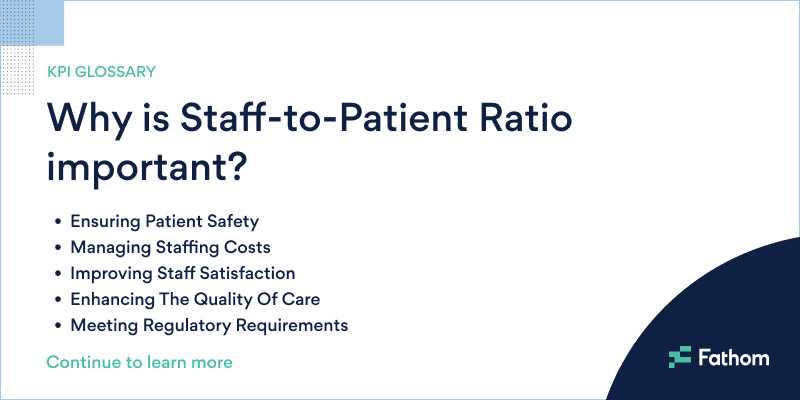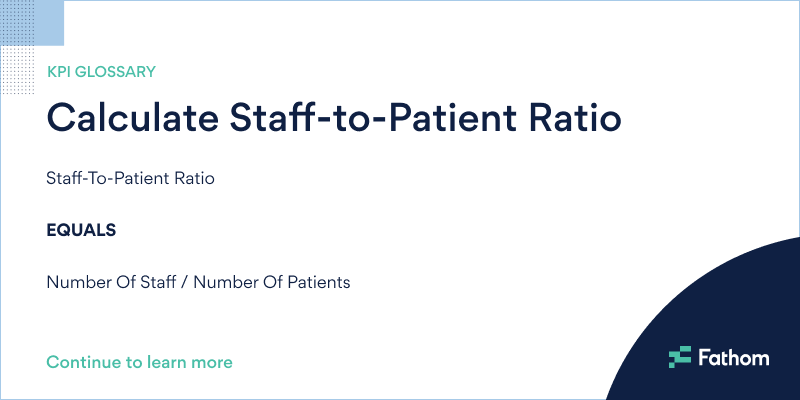
The quality of care that patients receive in a healthcare facility depends on various factors, including the number of staff available to attend to their needs.
The staff-to-patient ratio is a critical key performance indicator (KPI) that measures the number of staff available per patient in a healthcare facility. It's an important metric that healthcare providers can use to assess their resource management strategies and optimise their operations.
In this article, we'll explore the importance of staff-to-patient ratio as a KPI for healthcare practices. We'll discuss the key benefits of maintaining an optimal ratio, the potential risks of understaffing, and the best practices to ensure a healthy ratio. By understanding the significance of this KPI and how to measure and improve it, healthcare providers can deliver better care and achieve better financial performance.
"The most important KPI in healthcare is the staff-to-patient ratio. It's not just about numbers, it's about ensuring that patients receive the best possible care and attention."
- Dr. Atul Gawande, surgeon and author.
The staff-to-patient ratio is a KPI that measures the number of staff members available per patient in a healthcare facility. The ratio is calculated by dividing the number of staff members by the number of patients. The purpose of this KPI is to help healthcare providers assess their resource management strategies and ensure that they have enough staff available to provide quality care to their patients.
Maintaining an optimal staff-to-patient ratio is critical to delivering high-quality care and ensuring patient safety. An understaffed facility can lead to overworked staff, burnout, and a decline in the quality of care delivered to patients. On the other hand, overstaffing can lead to unnecessary costs and inefficient resource utilisation.
By measuring and monitoring staff-to-patient ratio, healthcare providers can identify staffing gaps, optimise staffing levels, and ensure that they are providing quality care while managing costs. This KPI is particularly crucial in hospital settings, where patient needs are often complex and require a significant amount of staff attention.
Overall, staff-to-patient ratio is a crucial KPI for healthcare providers to track and optimise to ensure that they are delivering high-quality care to their patients while managing costs and resources efficiently.
Tracking staff-to-patient ratio is important for several reasons:
Ensuring patient safety:
By maintaining an optimal staff-to-patient ratio, healthcare providers can ensure that each patient receives the attention and care they need. When there are not enough staff members to attend to patients, it can lead to longer wait times, delayed responses to emergencies, and a decline in the quality of care.
Managing staffing costs:
By tracking staff-to-patient ratio, healthcare providers can optimise their staffing levels and ensure that they are not overstaffed or understaffed. This can help them manage their staffing costs effectively while still providing quality care to their patients.
Improving staff satisfaction:
When there are enough staff members to attend to patients, staff members are less likely to feel overworked or burned out. By optimising staff-to-patient ratio, healthcare providers can create a more positive work environment for their staff, which can improve staff satisfaction and retention rates.
Enhancing the quality of care:
When there are enough staff members to attend to patients, healthcare providers can deliver higher-quality care. Patients are more likely to receive prompt attention, have their needs met quickly, and experience better outcomes.
Meeting regulatory requirements:
Many healthcare regulatory agencies require healthcare providers to maintain a specific staff-to-patient ratio to ensure patient safety and quality of care. By tracking this KPI, healthcare providers can ensure that they are meeting these requirements.
Overall, tracking staff-to-patient ratio is critical for healthcare providers to optimise their staffing levels, ensure patient safety, deliver high-quality care, and manage costs effectively. By using this KPI, healthcare providers can improve their operations, enhance patient outcomes, and achieve better financial performance.

When measuring the staff-to-patient ratio KPI, there are several limitations to consider:
Overall, healthcare providers should be aware of these limitations when measuring and interpreting the staff-to-patient ratio KPI. By considering these factors, they can ensure that they are accurately assessing their staffing needs and optimising their operations to deliver high-quality care to their patients.
It is simple to calculate the staff-to-patient ratio with the following formula:
For example, if a hospital has 50 staff members and 100 patients, the staff-to-patient ratio would be:
Staff-to-Patient Ratio = 50 / 100 = 0.5
This means that there is 1 staff member for every 2 patients.

The benchmarks may vary based on the type of healthcare facility, patient acuity, and other factors. Generally, the American Medical Association (AMA) recommends a staff to patient ratio of 1.5 full-time equivalent (FTE) staff per physician for primary care practices.
This means that for every one physician in a primary care practice, there should be 1.5 FTE staff members, including nurses, medical assistants, and administrative staff. This ratio may be adjusted based on the size of the practice and the number of patients seen per day.
Specialty practices may have different staffing needs based on the specific services they offer. For example, practices that perform procedures or surgeries may require additional nursing or surgical staff.
Ultimately, the goal should be to maintain a staff-to-patient ratio that allows for safe and effective care delivery.
When measuring the staff-to-patient ratio, there are several common errors that healthcare providers should be aware of, including:
Improving the staff-to-patient ratio KPI can help healthcare providers ensure that they are providing safe and effective care to their patients. Here are some strategies to improve this KPI:
Increase staffing levels
One way to improve the staff-to-patient ratio is to hire additional staff members. This can help ensure that there are enough staff members to meet the needs of all patients.
Adjust staffing mix
Another way to improve the staff-to-patient ratio is to adjust the mix of staff members. For example, adding more support staff or nurse assistants can help reduce the workload of nurses, allowing them to provide better care to patients.
Utilise technology
Technology can be used to automate certain tasks, reducing the workload of staff members and freeing up their time to focus on patient care.
Implement workload management strategies
Workload management strategies can help ensure that staff members are not overwhelmed with work, which can improve their ability to provide quality care to patients.
Increase patient acuity awareness
By having a better understanding of patient acuity, healthcare providers can better allocate staffing resources to meet the needs of patients with higher care needs.
Improve patient flow
Improving patient flow can help reduce wait times and allow staff members to provide more timely care to patients, which can improve the staff-to-patient ratio.
Ultimately, the goal should be to maintain a staff-to-patient ratio that allows for safe and effective care delivery.
There are several variations of the "staff-to-patient ratio" KPI depending on the context and industry. Some of the common variations are:
The main difference between these variations of the KPI is the industry or context in which they are used. However, they all share the common goal of measuring the ratio of staff to the people they are serving, in order to ensure that adequate resources are available to provide quality service.
What is the staff-to-patient ratio KPI?
The staff-to-patient ratio KPI is a measure of the number of staff members available to care for a certain number of patients. It is typically expressed as a ratio, such as 1:4, which means one staff member for every four patients.
Why is the staff-to-patient ratio KPI important?
The staff-to-patient ratio KPI is important because it can have a significant impact on the quality of care that patients receive. If there are not enough staff members to care for the number of patients, it can lead to longer wait times, decreased attention to individual patient needs, and increased risk of medical errors.
How is the staff-to-patient ratio KPI calculated?
The staff-to-patient ratio KPI is calculated by dividing the number of staff members by the number of patients. For example, if there are 20 staff members and 80 patients, the ratio would be 1:4.
What is a good staff-to-patient ratio?
The ideal staff-to-patient ratio will vary depending on the type of healthcare facility and the needs of the patients. However, in general, a ratio of 1:4 or better is considered to be a good benchmark.
How can healthcare facilities improve their staff-to-patient ratio?
Healthcare facilities can improve their staff-to-patient ratio by hiring additional staff members, increasing the efficiency of existing staff, and implementing technology solutions that can help automate certain tasks. It is also important to regularly review and adjust staffing levels based on patient needs and other factors.